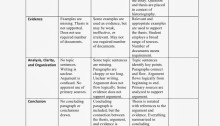Introducing Introductions
In my U.S. history survey course, I base student grades partly upon two major writing assignments — brief (3-5 page) essays involving a focused inquiry into a historical problem of a student’s own choosing, based upon an analysis of archival sources from their own research. (This is where their source analysis worksheets come in handy…


